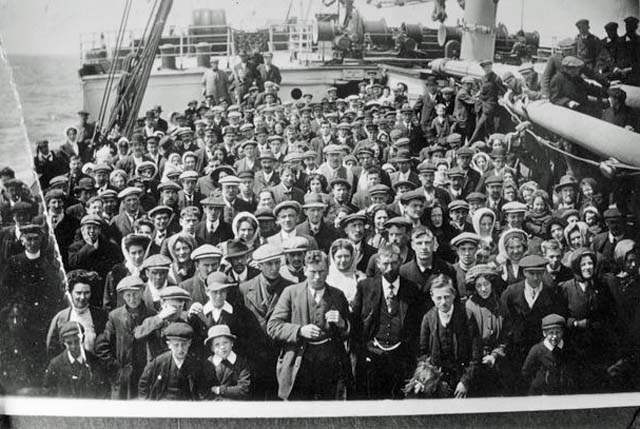|
On board the Empress of Ireland - Date/Photographer unknown.
26 May 2014
Service to Remember Forgotten Empress of Ireland Which Sank 100 Years Ago with the Loss of 1,012 Lives
Liverpool England United Kingdom - It was a massive shipping tragedy with major Merseyside connections, and one which was overlooked
for decades, but the "forgotten" Empress of Ireland will be remembered in Liverpool on the centenary of her loss this Thursday, thanks to the
city-born grandson of her chief officer.
The Canadian Pacific Railway Company's luxury liner was registered in Liverpool and made regular voyages between the city and Canada.
She also employed a large number of Liverpool men, many from the Scotland Road area.
With 1,477 people on board, she sank in the icy waters of the St Lawrence River in the early hours of 29 May 1914, shortly after leaving Quebec en route for
Liverpool.
And it was a sudden death, the ship sank in just 14 minutes after a fog-bound collision with the Norwegian vessel Storstad.
The Titanic had perished two years earlier, in April 1912, while the Lusitania was to be lost in May 1915.
Both names are etched on millions of minds.
But the Empress of Ireland was later dubbed the "Forgotten Empress", and yet, in passenger terms, she ranks as the worst of the three
tragedies.
Of the 1,012 to die, 840 were passengers and 172 were crew, compared with 807 and 696 respectively on the Titanic, and 785 and 415 on the
Lusitania.
Chief officer Mansfield Steede died a hero after rushing from his bed in his pyjamas and, after instructing a radio officer to send distress calls, releasing
lifeboats which saved many on board.
The 47-year-old was born in County Cork, Ireland, but moved to Liverpool as a teenager and later lived in Anfield with his wife, Anne, and their three
children, and it was his grandson, also Mansfield, whose intervention led to this Thursday's commemorative service being organised.
Mr. Steede, 78, formerly of Norris Green, left Liverpool when he was 20 and, like his grandfather, worked for a time for the Elder Dempster Line.
He later became director of an air freight agency and today lives in Selsey, West Sussex.
He contacted the ECHO's Shipping Lines columnist Peter Elson to ask if Liverpool was marking the centenary.
Nothing had been planned, but Mr. Steede then spoke to Dave Ramsey, at Liverpool Town Hall, who put him in touch with Pat Moran, chairman of the Liverpool
Retired Seafarers' Association and the Merchant Navy Day Committee, and the latter has organised the Empress of Ireland Centenary Commemoration service, which
will take place at 2;30 p.m. this Thursday at Our Lady and St. Nicholas Parish and Seafarers' Church in Chapel Street, Liverpool.
Mr. Steede says: "The disaster is being marked in Canada and I thought someone along the line might have picked it up and done something in
Liverpool, but I'm really happy that there is now going to be this service which I will be attending."
His grandfather died in the act of helping others, as reported by a Captain James Anderson Murray, harbour master of Quebec, who had previously been in command
of the Empress of Ireland.
He stated: "The conduct of the officers and crew is typified by that of chief officer Steede, who hurried up in his pyjamas and started setting the
boats free with the result that he was crushed to death by a boat falling on him when the ship lurched."
He added: "Before he was killed, Mr. Steede loosed several boats which saved a number of people."
His grandson says: "I am very proud of my grandfather. He was 6 feet 5 inches and a very powerful swimmer, he must have been dead before he hit the
water."
Back home in Liverpool, there was devastation, for Mansfield Steede's family and scores of others.
Churches throughout Merseyside held memorial services with special funds also being set up, the Lord Mayor of Liverpool's being the largest.
The anguish of so many Liverpool families was made even more poignant by the scenes of joy which greeted some 72 survivors of the liner's crew, who arrived at
Liverpool's Exchange Station after earlier docking in Glasgow.
All belonged to the engine room and stoking departments of the Empress, with many coming from the Scotland Road district.
Regarding his grandmother, Anne, Mr. Steede explains: "She never got over what happened and wore black until the day she died, very many years
later. When she was told what had happened, she said she couldn't believe it, and that it was impossible and couldn't have happened. She and my grandfather had
three children, two boys and a girl, and were living in Clovelly Road, close to Anfield Road. They had put a deposit down on a big house in Aigburth, but then
my grandfather died. My grandmother had never worked before, but now she had to do menial work, including sewing, in a bid to make ends meet. She had
previously been cut off by her own family, because she had married a common seaman, who had come over to Liverpool from Ireland to serve an apprenticeship with
J.S. deWolf & Company."
David Zeni is the author of "Forgotten Empress - The Tragedy of the Empress of Ireland", which has previously featured in the ECHO (it is still
available from Wirral-based Avid Publications, call 01745 886769 or email info@avid publications.co.uk for more details), and he said: "Never before
had so many Liverpool seafarers been at risk on a single vessel. Some 200 families were directly affected. Countless others would lose lifelong friends and
acquaintances. The Scotland Road district, home to many stokers, became a neighbourhood of widows and fatherless children."
David Roberts, of Avid Publications, says today: "In the book, David Zeni calls the Empress an unrecognised stepchild in a family of maritime
tragedies."
Regarding the ship's low profile, the publisher adds: "While the Titanic is a name known the world over, and the impending centenary in Liverpool in
2015 of the highly-controversial loss of the Lusitania adds to the world's knowledge of that ship, the Empress remains a Forgotten Empress, even though more
passengers were lost on her than on the Titanic or the Lusitania."
As well as being sandwiched between two high-profile disasters and being affected by the outbreak of World War I just two months later, David Roberts further
explains: "She was also a long way from home, so the responsibility for rescue, recovery, salvage, burials, and so on would not lie with the British
authorities, but the Canadian. Some 171 of the passengers travelling on the ship were members of The Salvation Army, who were sailing to Britain to participate
in an international gathering in London. More than 150 Salvationists perished, including 30 of the 39 members of the Canadian Staff Band."
Among the Empress of Ireland's survivors was its captain, Henry George Kendall, who was born in London but brought up in Everton and, while captain, lived in
Brighton-le-Sands.
Lord Mersey, who presided over the Titanic inquiry, was one of three members of the Empress of Ireland court of inquiry which exonerated Captain
Kendall.
The Storstad's first officer was found negligent in changing course in the fog and not calling the captain.
Mansfield Steede adds: "The Empress of Ireland disaster has been overlooked and neglected over the years, not least because of the outbreak of World
War I shortly afterwards, and everything since seems to have been about the Titanic. That is why it's so important to mark the centenary this
week."
Paddy Shennan.
   |

